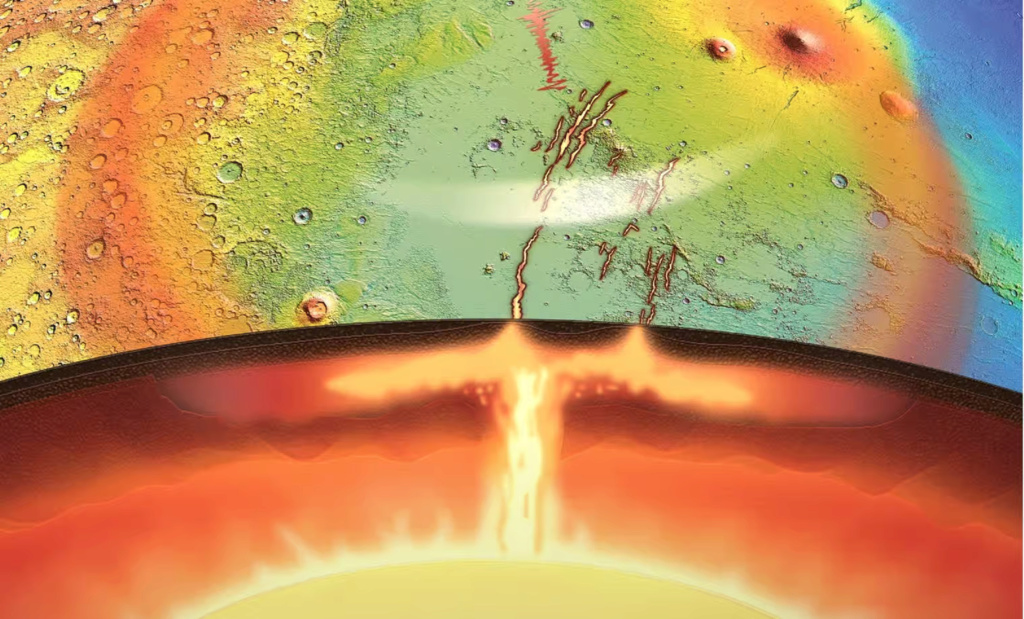!Mars is not “dead” inside

While Mars was thought to have been a "dead" planet geologically speaking for several billion years, a new study brings new elements which suggest that it would indeed be active, especially at depth.
Is Mars really a "dead" planet? On closer inspection, maybe not as much as we thought. What is certain is that the immobility of its surface and above all the absence of major geological manifestations, such as the powerfulearthquakesand thevolcanic eruptions, have long suggested that the Red Planet no longer possesses internal dynamics similar to those experienced by the Earth and which is notably responsible for plate tectonics .
Mars, however, has manyvolcanoes(including Olympus Mons , which is the highest in theSolar system), suggesting that the planet was indeed active in its youth. But it seems that for 3 billion years, no major geological event has occurred. A new study, published in the journal Nature Astronomy , suggests that this view may be wrong. Because the absence of geological manifestation on the surface does not necessarily mean that nothing is happening in the depths of the planet.
Dead on the surface but alive inside
A team of scientists from the University of Arizona have indeed discovered that thecoatof Mars was far from calm and motionless and that it would be animated by convection currents that could cause earthquakes but also volcanic eruptions. Despite its resolutely dormant area, the planet would hide in its depths a much more tumultuous activity than we thought.
A giganticmantle plumehas indeed been detected within the Martian mantle. This type of geodynamic manifestation is well known on Earth anddooroften the name of hotspot ". It is a rise of hot mantle material, which forms a sort of column rising from the base of the mantle to under thecrust. On Earth, mantle plumes are often the source of avolcanismintense. Considered fixed with respect to themovementof thetectonic plateson the surface, hot spots often give rise toarchipelagosof volcanic islands like Hawaii. On Earth, this activity which takes place within the mantle and which involves significant exchanges ofheatbetween the base of the mantle and the surface of the planet is one of the drivers of plate tectonics . It is possible that such activity also takes place onVenus, but this is the first time that it has been highlighted on Mars.

unlike its apparently dead surface, the mantle of mars would be animated by convection currents giving rise to a large mantle plume.
cereberus fossae: surface manifestations of deep activity
!This discovery is also surprising since Mars was now considered too cold to support such internal activity and the few earthquakes currently recorded were rather associated with passive processes related to the cooling of the planet. And yet, one region has caught the attention of scientists: Elysium Planitia . This vast plain located in thenorthern hemisphere, close to theequatorof Mars, indeed bears traces of relatively recent major volcanic eruptions , less than 200 million years old. This observation is in contradiction with the rest of the planetary surface which has not been altered by volcanism for several billion years. Ash deposits associated with a small volcanic explosion could even date back only 53,000 years

cereberus fossae in elysium planitia is characterized by large recent fractures that cut through the crust of mars.
The volcanism of Elysium Planitia would originate from a network of large recent fractures ( Cereberus Fossae ) cutting through the Martian crust . The analysis of earthquakes recorded by theseismometerof Insight, placed on the surface of Mars, has also shown that almost all endogenous earthquakes (unrelated to the fall of a meteorite) have their source in this region . A tectonic and magmatic activity which, if far from the intensity of that of the Earth, means that geodynamic processes are indeed playing out in the depths of Mars. By observing this region more closely, the scientists realized that the surface there was significantly raised and that this local bulge was associated with aanomalyof the field ofgravity. These clues show that the Martian crust is here supported by an active upwelling of hot material in the large mantle. THEmodelingindeed suggest the presence of a giant plume more than 4,000 kilometers wide rising under Cereberus Fossae and affecting an area equivalent to that of the United States. It is this plume that would be at the origin of the fractures in the crust but also of recent volcanism and earthquakes.
An interesting region for the search for life on Mars
This discovery raises many questions about the internal dynamics of the planet and involves reviewing previously established models. On the other hand, it is an interesting fact concerning life on Mars. Because who says mantle plume and volcanism says source of heat: an essential ingredient for the development of living organisms. Moreover, this thermal anomaly could have maintained water in liquid form for adurationrelatively long. On Earth, this type of environment where water and heat are associated is rich in life, especially inbacteria. The secrets that Cereberus Fossae still contains could therefore shed light on the geodynamic but also biological evolution of the Red Planet .
Source :websites

